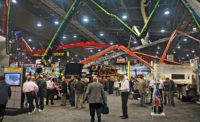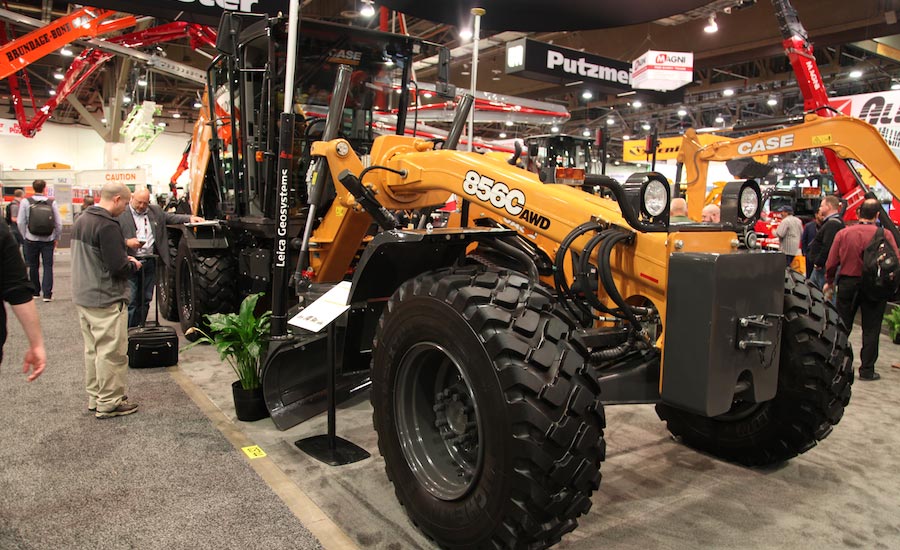Strong Demand for New Machines at World of Concrete 2018
With construction markets hot, equipment makers look to move heavy iron

The annual World of Concrete equipment trade show drew over 60,000 visitors this year to Las Vegas, Jan. 22 to 25.
Photo by Jeff Rubenstone for ENR

Portland Cement Association Chief Economist Ed Sullivan gives his annual construction forecast at World of Concrete 2019.
Photo by Jeff Rubenstone for ENR

Case Construction Equipment rolled out its latest machines on the show floor, including one of its new C-Series motor graders.
Photo by Jeff Rubenstone for ENR

Pettibone has expanded its X-Series of telehandlers with the 1258X Traverse.
Photo by Jeff Rubenstone for ENR

Hilti's new concrete wall saw features automatic depth control and full remote operation, reflecting a trend toward automation that the company expects will help to compensate for skilled labor shortages across the industry.
Photo by Jeff Rubenstone for ENR





The crowds swelled through the gates of World of Concrete in Las Vegas, and equipment manufacturers were eager to sell through their stock as a strong construction market hits its stride.
The annual trade show, held Jan. 22 to 25 at the Las Vegas Convention Center, saw thousands of attendees looking over the latest construction equipment. A federal government shutdown placing some infrastructure work in limbo didn’t seem to dampen spirits at the show, where concrete contractors showed strong interest in building out their fleets to meet construction demand. Over 60,000 attendees saw exhibits from over 1,500 companies at the show, the largest show in ten years, according to organizers.
Good Times, But Clouds on the Horizon
But despite optimism on the show floor, industry groups at the show were a bit more skeptical of how long the party will last. “A lot of people can be uncertain, even confused, about where the economy lies right now,” says Ed Sullivan, chief economist for the Portland Cement Association. At his annual economic briefing at World of Concrete, Sullivan said that despite uncertainty rooted in the government shutdown and no real action on infrastructure spending, economic fundamentals are strong.
But while the PCA is forecasting a 2.9% increase in cement consumption in 2019, high labor costs and rising interest rates may cause demand to tail off in the following years. “The environment into which construction is entering is something we really haven’t seen for over 10 years,” say Sullivan. The construction industry has gone through an era of relatively low inflation and low interest rates which is showing signs of ending. Rising interest rates will likely soften what has been a strong trend for homebuilding in the U.S., and have other knockdown effects on the rest of the industry, according to Sullivan.
PCA’s Sullivan also warned builders not to hold out for a major federal infrastructure bill to drive public construction. “We always thought that an infrastructure plan would emerge, but as we head into 2020 it looks like it’s gonna be even later than that,” he says. “As we start to look at it now, it’s not that white knight riding in on a stallion. It might be a much smaller knight, riding in on a donkey.” Sullivan says that unless there is action by Congress in the next few months, the next election cycle will delay any large federal infrastructure package until after 2020.
Based on that and other factors, PCA expects public construction to be lower than in earlier forecasts, driven by a smaller-than-expected federal infrastructure package as well as rising debt levels at the state level cutting into construction spending. And while rising labor costs are expected to continue to press construction as a whole, the biggest hit will be to single-family home construction where there is less room to raise wages. “If you’re building bridges, you’re building roads, you’ve got deeper pockets, you can pay these people a little better,” Sullivan told ENR. “But the areas that are more dominated by the smaller contractor with smaller margins, they’re going to struggle the most [with rising labor costs].”
Updated Machines to Meet Demand
Rather than pushing a plethora of new machines, many manufacturers were there to capitalize on an expected high demand for equipment. But there we a few new pieces of equipment floating around the show, including a few overdue improvements. Case Construction Equipment brought out its new C-Series motor graders, first announced in December. The 836C and 856C motor graders are available with factory installed 3D grade controls from Trimble or Topcon Positioning Systems.
Telehandler maker Pettibone is building out its range of Extendo and Traverse X-Series telehandlers that were on display at World of Concrete last year. The Traverse T1258X is a 12,000-lb class telehandler with a reach of 58 ft. Like other Traverse models, it has a horizontal extension for material placement, with 70 in. of reach on the T1258X.
Toolmaker Hilti reported strong sales in 2018, and continued to build out it’s concrete breaking and sawing lineup to meet demand. The new DST 20 electric concrete wall saw boasts full remote control operation, with a rail-mounted unit and integrated water sprayer for dust suppression. With a maximum cutting depth of 63 in. it’s well suited for larger cuts in concrete, and remote operation allows the user to begin setting up the next rail location while the saw is in operation.
Citing a strong construction market as a driver of recent tool sales, Hilti North America CEO Avi Kahn saw other opportunities for Hilti. “In this market environment where there is a lot of construction work and not enough skilled labor, our business model really comes to life,” he told assembled journalists, noting that the company’s emphasis on safety and automation in its tools reflects a broader industry need to help contractors ration the time and attention of their skilled laborers. According to Kahn, these tools will allow workers to “be faster and safer on the jobsite and get the most out of those precious skilled resources that they do have available to them.”









